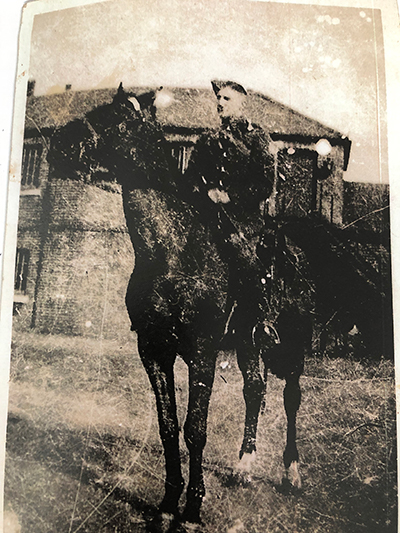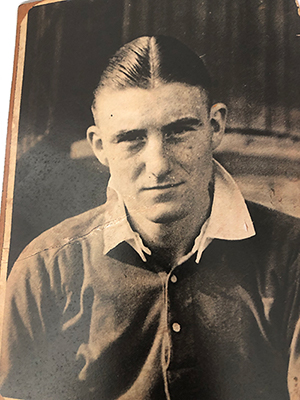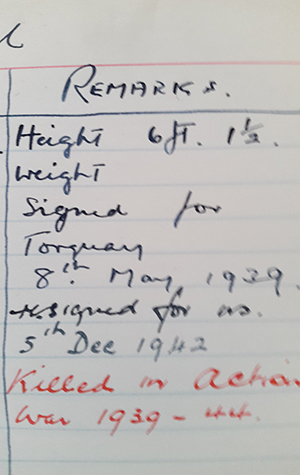Charlton’s Normandy Hero – Geoffrey Reynolds
15/08/2019 - 6.17
Ben Hayes
Back in January 2016, the Charlton Athletic Museum were proud to rediscover a Charlton player, Nobby Nightingale, who had played for the club and then been killed in action during World War One.
Today on 6 June, on the anniversary of D-Day, we are both proud and humble to re-introduce to the Addicks family another Charlton player who lost his life in conflict, only this time in World War Two.
It was not a name we knew but like so many things, the lead to him came via Colin Cameron. In one of the hundreds of documents recently handed over to the museum by the family of the late club statistician, was a short list of players from various clubs who had died in World War Two. In brackets after the name Geoffrey Reynolds was a note “A Charlton player”.
He wasn’t in Colin’s Valiant 500 book so who was he?
Via a Torquay United fans site - http://torquayfansforum.co.uk and from the museum’s own records we uncovered a romantic but ultimately tragic story.
Geoffrey Reynolds was born on 4 September 1919, to Harold and Ada Reynolds of Clare Gardens, New Eltham. Harold was from Paddington and Ada from Maidstone but they had married in the summer of 1914, just before the outbreak of the Great War. The road name no longer exists and it appears it is now a part of Footscray Road, only a few minutes’ walk from Charlton’s Sparrows Lane training ground.
Geoffrey was clearly a promising player, as after playing for local side Bexleyheath he was signed by first division Charlton Athletic on 3 September 1937, a day before his 18th birthday.
At over six foot one he was a strapping lad but he didn’t make the breakthrough into the Charlton first team that he would have hoped for. At the time, the Addicks were one of the strongest sides in the country.
On 8 May 1939, Geoff was released and joined Third Division South side Torquay United along with two other Charlton players. Ralph Calland would go on to play 223 first-team games for the Gulls scoring 14 times. Jack Conley would play 171 times for United scoring 76 goals. How many official games they would have played if they had not had to miss six years of the war, we shall never know but they were granted a joint testimonial in 1950.
Geoff Reynolds would never play a first-team game for Torquay United. He played in two public trial matches, a “reserve Football League Jubilee Fund” game and three Southern League matches before war broke out – all at left half. He did not play in any Torquay matches played after war had begun as Torquay did not take part in the wartime leagues.
Geoffrey joined the Life Guards in 1941. This famous cavalry unit were dismounted and converted to light armoured Daimler scout cars or the heavier staghound armoured vehicles. Posted to ‘A’ Squadron Reynolds rose to the rank of Lance Corporal of Horse.

[Geoffrey Reynolds of the Life Guards (Charlton Athletic Museum)]
That would have been the end of his connection with Charlton but when war had been declared on 3 September 1939, regular football came to a halt, leagues were re-organised and many players signed up for active service or as PT instructors.
This often, left teams short of players and it was a regular occurrence for players of other clubs to guest for teams close to where they were stationed. On one such occasion Charlton were travelling by train to an away game but were one player short. As the Daily Mirror of 23 December 1942 tells us
“Manager Seed and ten Charlton players were waiting on a railway station before an away match. One player short. A brawny Household Cavalry man, 6ft 2 ½ in, fourteen stone, approached the party and shook hands with goalkeeper Hobbins.
“Who’s that chap? Seed asked
“That, that’s Jeff Reynolds, used to play for us”
Seed thought and remembered Jeff Reynolds, the lanky boy of 17.
“Care for a game today?” Seed asked him. Jeff did care… and played as if he hadn’t a care in the world. And he will go on playing for Charlton, for Seed has now re-signed the boy he once forgot. For nothing…and all because when war broke out, Torquay also forgot – to place him on their retained list!”.
We checked the collection of player registration cards we hold in the museum and found the card for Geoff. And there it was, showing him as having re-signed for Charlton on 5 December 1942.

[Charlton Athletic Registration Card for Geoffrey Reynolds (Charlton Athletic Museum)
His first appearance seems to have been away to Aldershot on 5 September 1942, a day after his 23rd birthday so we must assume that this was the game were Reynolds met the travelling Addicks squad. Charlton lost 7 – 2 which would have partly been to Charlton’s scratch team (we had three other guest players that day as well as Reynolds) and that Aldershot, being a major army town, had the pick of some of the best players in the country.
Reynolds would go on to play three more times that season and once more in the next. He also played 13 times for York City in the 1943/4 season as a guest, presumably while stationed at Catterick or another local garrison.

[Geoffrey Reynolds – Charlton Athletic (Charlton Athletic Museum)]
With the Normandy Landings on the 6 June 1944 it wouldn’t be long before Geoffrey and his regiment would find themselves face-to-face with the enemy in North-West Europe.
As the reconnaissance screen for the British VIII Corps, the 2 Household Cavalry Regiment, of which Geoff Reynolds was a part, landed on Juno Beach on the 14 July. They went straight into the line to participate in Operation Goodwood (18/20 July). Although this large-scale tank battle saw heavy casualties among the British units engaged Geoffrey’s regiment came through this first experience of combat relatively unscathed.
This fortune was short-lived however, as the necessity to breakout from Normandy became more and more desperate. A new plan was devised, Operation Bluecoat, to launch on 31 July 1944. Part of a two-pronged attack with XXX Corps to the north and Reynold’s VIII Corps to the south swinging around the back of Caen and breaking through the main defensive German line.
The role of the 2 Household Cavalry Regiment was to gather intelligence and exploit any opportunities. As such they were at the vanguard of battle and it was during the confused fighting in and around the village of Bieville that Geoffrey Reynolds’ Staghound armoured car was hit. The wounded Reynolds was evacuated back through the beachhead and, just two weeks after landing in Normandy, returned to ‘Blighty’ flying back in the Handley Page Air Ambulance flights operating out of RAF Watchfield in Oxfordshire.
We cannot be sure of the type of wounds Geoffrey received, but he sadly was not to recover and eventually succumbed to his injuries just five days later, on the 4 August 1944, aged just 24.
He is now buried near to the air base where had he landed home at Watchfield Military Cemetery, Watchfield, Oxfordshire.
The inscription on his grave, presumably chosen by his parents, is taken from Rupert Brooke’s poem from 1915 “The Dead” and reads “He leaves A white unbroken glory, A gathered radiance, A width, A shining peace”

[Gravestone of Geoffrey Reynolds (Charlton Athletic Museum)]
His passing was noted by Charlton in red ink on his registration card with the simple words “Killed in Action War 1939 – 44”

[Additional details of Geoff Reynolds death added to his Charlton Athletic Registration Card (Charlton Athletic Museum)]
It seems an unsuitable epithet for a young man who was rejected by his local team only to be given another chance due to a brief encounter on a wartime train platform. It reads like a boy’s own story but he was never to have the chance to fulfil his potential in football or in life.
Biography

Ben Hayes is one of the founding trustees of the Charlton Athletic Museum and a third generation Addick who can trace his family’s support back to the Addicks’ pre-football league days.
He has played an active part within supporters’ organisations connected to Charlton Athletic and was an elected director of the club from 2005 to 2007. He is currently secretary of the Bromley Addicks group.


/prod01/wlvacuk/media/departments/digital-content-and-communications/images-2024/240624-Alumni-Awards-2024-Resized.jpg)
/prod01/wlvacuk/media/departments/digital-content-and-communications/images-18-19/220325-Engineers_teach_thumbail.jpg)
/prod01/wlvacuk/media/departments/digital-content-and-communications/images-2024/240627-UN-Speaker-Resized.jpg)
/prod01/wlvacuk/media/departments/digital-content-and-communications/images-2024/240320-Uzbekistan-Resized.jpg)
/prod01/wlvacuk/media/departments/digital-content-and-communications/images-2024/240229-The-Link-Resized.jpg)
/prod01/wlvacuk/media/departments/digital-content-and-communications/images-2024/240627-Lady-Aruna-Building-Naming-Resized.jpg)